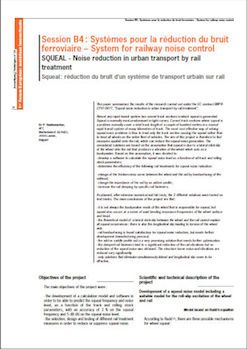Session B4: Systèmes pour la réduction du bruit ferroviaire – System for railway noise control
-
Auteur :
VANHONACKER P. -
Auteur moral :
-
Année de parution :
2001 -
Résumé :
This paper summarises the results of the research carried out under the EC contract BRPRCT97- 0477, “Squeal noise reduction in urban transport by rail treatment”. Almost any rapid transit system has curved track sections in which squeal is generated. Squeal is normally most predominant in tight curves. Curved track sections where squeal is a problem normally cover a total track length of a couple of hundred metres in a normal rapid transit system of many kilometres of track. The most cost effective way of solving squeal noise problems is thus to treat only the track section causing the squeal rather than to treat all wheels on the entire fleet of vehicles. The aim of this project is therefore to find measures applied onto the rail, which can reduce the squeal noise generation. The considered solutions are based on the assumption that squeal is due to a lateral stick-slip of the wheel onto the rail that produces a vibration of the wheel which acts as a loudspeaker. Based on this assumption, it was decided to : - develop a software to calculate the squeal noise level as a function of all track and rolling stock parameters ; - determine the efficiency of the following rail treatments for squeal noise reduction : - change of the friction-creep curve between the wheel and the rail by hardsurfacing of the railhead ; - change the impedance of the rail by an add-on profile ; - increase the rail damping by specific rail fasteners. As planned, after intensive numerical and lab tests, the 3 different solutions were tested on test tracks. The main conclusions of the project are that : - it is not always the loudspeaker mode of the wheel that is responsible for squeal, but squeal also occurs at a series of axial bending resonance frequencies of the wheel surface and tread. - the theoretical model of a lateral stick-slip between the wheel and the rail cannot explain all squeal occurrences : there is also the longitudinal slip leading to torsion of the wheel axle. - rail hardsurfacing is found satisfactory for squeal noise reduction, but needs further development (manufacturing process). - the add-on saddle profile rail is a very promising solution that needs further optimisation. - the damped rail fasteners lead to a significant reduction of the rail vibrations but no reduction of the squeal noise was obtained. The structure borne noise and vibrations are reduced very significantly. - only solutions that eliminate simultaneously lateral and longitudinal slip seem to be effective. -
ISBN :
-
Thématique(s) :
Équipements, technologies et recherche, Transports et mobilités -
Type de contenu :
Article scientifique -
Mot(s) clé(s) :
-
Langue :
Français -
Disponible en prêt au CidB :
Oui -
Réf. CidB :
78/09563 -
Lien de téléchargement :


